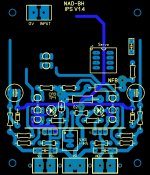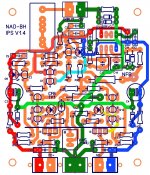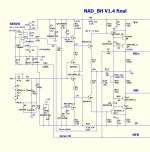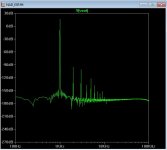Hi OS,
I see in some of your IPS you use KSA1015/KSC1815. Are these comparable to the BC550/560? Do you have a preference?
Thanks, Terry
I see in some of your IPS you use KSA1015/KSC1815. Are these comparable to the BC550/560? Do you have a preference?
Thanks, Terry
1015/1815 , BC550/560 - same deal ...
1845/992 , BC639/640 - same deal , except the 639/640 is 80V ...
dadod says they suck ???
Only Q5 and 6 (CFB) + Q9 and 10 (VAS cascode) need to be high
Vceo.
Looks like most BCxxx sources are style 17 , which is EBC.
I'll make this IPS EBC , except for the 2 high voltage semi's.
PS - some say BCxxx sounds better ? truth or B$ ?😀
OS
1845/992 , BC639/640 - same deal , except the 639/640 is 80V ...
dadod says they suck ???

Only Q5 and 6 (CFB) + Q9 and 10 (VAS cascode) need to be high
Vceo.
Looks like most BCxxx sources are style 17 , which is EBC.
I'll make this IPS EBC , except for the 2 high voltage semi's.
PS - some say BCxxx sounds better ? truth or B$ ?😀
OS
The 1015/1815 are still high-voltage Japanese transistors. One of them shows signs of having good Vcesat behavior but that's only speculation based on the datasheet charts, which may not tell the whole story. Personally, I would only use BC5xx/BC3x7 for current mirrors and Baxandall pairs because I have tested both of them to have excellent low-Vce behavior.
The 992/1845 are as bad as any high-voltage japanese transistor in low-Vce positions. For 4Vce or higher any transistor should work fine though, it's when you go under this you start to have problems.
As for the "sound" of these transistors... If the BC5xx has it's own sound then you should pay attention to the distinction between Fairchild, OnSemi (Motorola) and NXP (Phillips). The OnSemi/Motorola parts are faster. The same goes for the BC3x7.
The BC639/640 are versions of the BD13x/14X series, which varies from slow to very fast depending on whether the source is ST, ONSemi, NXP, and on and on... The KSC1845/A992 are much faster small-signal transistors, so I wouldn't ordinarily consider both for the same duty.
The 992/1845 are as bad as any high-voltage japanese transistor in low-Vce positions. For 4Vce or higher any transistor should work fine though, it's when you go under this you start to have problems.
As for the "sound" of these transistors... If the BC5xx has it's own sound then you should pay attention to the distinction between Fairchild, OnSemi (Motorola) and NXP (Phillips). The OnSemi/Motorola parts are faster. The same goes for the BC3x7.
The BC639/640 are versions of the BD13x/14X series, which varies from slow to very fast depending on whether the source is ST, ONSemi, NXP, and on and on... The KSC1845/A992 are much faster small-signal transistors, so I wouldn't ordinarily consider both for the same duty.
Last edited:
The 1015/1815 are still high-voltage Japanese transistors. One of them shows signs of having good Vcesat behavior but that's only based on the datasheet charts, which may not tell the whole story. Personally, I would only use BC5xx/BC3x7 for current mirrors and Baxandall pairs because I have tested both of them to have excellent low-Vce behavior.
The 992/1845 are as bad as any high-voltage japanese transistor in low-Vce positions. For 4Vce or higher any transistor should work fine though, it's when you go under this you start to have problems.
As for the "sound" of these transistors... If the BC5xx has it's own sound then you should pay attention to the distinction between Fairchild, OnSemi (Motorola) and NXP (Phillips). The OnSemi/Motorola parts are faster. The same goes for the BC3x7.
It's a one way street now.
I'm laying it out for mostly BCxxx. For the current sources .... BCxxx
should not present any problem ?? Only 12V for this part of the amp.
Servo path(s) will be very short - different than my first versions.
PS - Builders will have the choice of any EBC offering...
OS
Attachments
PS - some say BCxxx sounds better ? truth or B$ ?😀
Well, I wouldn't distinguish the "sound" of a single transistor in the designs we normally discuss here 😛, but BC5XX is a low-noise, high-gain and performs normally even at extremely low Vcb (Vce), where many other ones would be already at the edge (or below) of normal operation, entering rather non-linear territory...
It's a one way street now.
I'm laying it out for mostly BCxxx. For the current sources .... BCxxx
should not present any problem ?? Only 12V for this part of the amp.
Servo path(s) will be very short - different than my first versions.
PS - Builders will have the choice of any EBC offering...
OS
No problem with CCSs from my perspective...
I like your approach of moving back-to-front here 🙂
Cheers,
Valery
The layout says v1.4 but there's only a v1.3 posted. What is different?
I looked back and Thimios already tested a 1.3 (of the old nad/gonad). 😱
I suppose you could just call it "BH" ... it is the only IPS with
(Baxandall/Hawksford) .
PS - except for vzaichenko's 😀 .
OS
No problem with CCSs from my perspective...
I like your approach of moving back-to-front here 🙂
Cheers,
Valery
What is "back-to-front" ???
Layout wise ?
OS
What is "back-to-front" ???
Layout wise ?
OS
Yes. In many cases I start from the input, but now I see some advantages of doing it in the opposite direction

Ah, yes. The GoNAD-BH designation works to keep it distinct from what came before it.
I plan on a slightly different road, keeping with a 'standard' size like I have done with the others. Makes the mix and match a little easier. It will be tight where it needs to be a roomier where it can be.
I work like OS, generally from the IPS-OPS interface towards the input and in functional blocks.
I plan on a slightly different road, keeping with a 'standard' size like I have done with the others. Makes the mix and match a little easier. It will be tight where it needs to be a roomier where it can be.
I work like OS, generally from the IPS-OPS interface towards the input and in functional blocks.
Ah, yes. The GoNAD-BH designation works to keep it distinct from what came before it.
I plan on a slightly different road, keeping with a 'standard' size like I have done with the others. Makes the mix and match a little easier. It will be tight where it needs to be a roomier where it can be.
I work like OS, generally from the IPS-OPS interface towards the input and in functional blocks.
It is logical ... 😀
Standard size ?? 76 X 88 mm ?? We need to be on the same road , JK. 😉
I was going to use that extra 12mm for input cap embellishment.
If I "poop" out a true hawksford (cordell) error-correcting vertical/lateral MOSFET universal output board ,should 76mm be the target ??
PS - that is the "road" to go for the FET's ...

OS
It is logical ... 😀
Standard size ?? 76 X 88 mm ?? We need to be on the same road , JK. 😉
I was going to use that extra 12mm for input cap embellishment.
If I "poop" out a true hawksford (cordell) error-correcting vertical/lateral MOSFET universal output board ,should 76mm be the target ??
PS - that is the "road" to go for the FET's ...
OS
I go a little more generous with the real estate at 76x102 (3"x4"). For 'simpler' designs that might seem overkill but I'm fond of making them all identically dimensioned if possible. It makes prep work easier and a swap out of an IPS does not require moving mounting hardware. I'm sure you have had a look at my layouts and I think the format works.
Another thing I mentioned in your absence was ensuring input impedance, input filter fc, and CL gain are all the same. If someone really wants to try out more than one design we wouldn't want to skew the listening experience with differences we have control over.
I would try to meet the same footprint for an EC MOSFET OPS as is already established if possible to allow one set of heat sink drillings for all OPS of the same number of output pairs.
76 X 102 ... good. Lot's of room and extra embellishment.
- input filter Fc .... most are between 1.2 - 1.5mhz -3db.
I just did the 3 VFA's.
- Z ,I also did the new NAD , the diamond is much higher Z (than a VFA LTP).
While we can set a static Z for the input (47K) , the Fc is higher.
Different topologies will have unique dynamic Z.
-CLG is 27-29db for all the IPS's. I set these with the most common
JEDEC resistor ratio's. Of course, if anyone wants exactly 28db , a couple
DB will not throw PM "to the wind" ... but they will have to source
non-standard R values.
PS - new NAD is 28.8db.
So, I have standardized "loosely" ..... the best I think , considering the
wide array of designs.
(some differences we don't have control over)
OS
OS
- input filter Fc .... most are between 1.2 - 1.5mhz -3db.
I just did the 3 VFA's.
- Z ,I also did the new NAD , the diamond is much higher Z (than a VFA LTP).
While we can set a static Z for the input (47K) , the Fc is higher.
Different topologies will have unique dynamic Z.
-CLG is 27-29db for all the IPS's. I set these with the most common
JEDEC resistor ratio's. Of course, if anyone wants exactly 28db , a couple
DB will not throw PM "to the wind" ... but they will have to source
non-standard R values.
PS - new NAD is 28.8db.
So, I have standardized "loosely" ..... the best I think , considering the
wide array of designs.
(some differences we don't have control over)
OS
OS
Last edited:
Yes they were all 'similar'. Some used 22K/820R and others used 15K/560R. Only a fraction off from one another but why not make them exact by using the same values consistently. That's what I'm driving at. Leave no possibility of anyone saying one sounds better or worse because of difference 'X'. Some input filters were slightly different. Yes way over the audio band anyway, but not quite the same.
Maybe I'm just picking nits. Anyway, it's all good and it is just a suggestion to remove any doubts.
Maybe I'm just picking nits. Anyway, it's all good and it is just a suggestion to remove any doubts.
Yes they were all 'similar'. Some used 22K/820R and others used 15K/560R. Only a fraction off from one another but why not make them exact by using the same values consistently. That's what I'm driving at. Leave no possibility of anyone saying one sounds better or worse because of difference 'X'. Some input filters were slightly different. Yes way over the audio band anyway, but not quite the same.
Maybe I'm just picking nits. Anyway, it's all good and it is just a suggestion to remove any doubts.
Use a can of poison for head lice. 😀
I fully understand. I even know the "subjects"
15K/560 is the "spook" - here we are driving 2 differentials ... FB Z must
be lower to compensate. We could use 22K/820R on the spook , and
lose some slew. I was trying to make the spook match a CFA in this aspect.
I "slipped" on the wolverine (also 15k/560).
It can run 22K/820 FB ratio with no degradation.
PS - No dang good reason for 15K/560 here. 😱😱
"Symasui" is also 22k/820 .. good to go.
Input Fc would not be audible , it could affect slew ... so I made it higher
for the CFA's.

15K or 22K input Z would not be noticed by a preamp.
A difference in CLG would be most noted - most definitely.
Some might misinterpret this as a "stronger amp" 😀😱
Judging the "book by its cover".
These are trivial things ... you might get 1% change (better or worse) ,
but these amps are so good - would you hear it ?
OS
If you want the amps to sound different, give one of them one click more on the volume control. You'll swear that one is the "stronger amp".
I looked back and Thimios already tested a 1.3 (of the old nad/gonad). 😱
I suppose you could just call it "BH" ... it is the only IPS with
(Baxandall/Hawksford) .
PS - except for vzaichenko's 😀 .
OS
Nad ver.1.3 is on post 832,963,967,988,989,1005.
Thimios.
And here is V1.4 - last one.
To keep it the same design , this is
best. Of course , we have a "NEW" VAS (baxandall/hawksford).
(below 1/2) is the draft. Many grounds to go around 😀 ..green traces.
This is the more typical CFA design out there in OEM land.
It does tend to get to the 20-30ppm level with output , but
so does the CFA-X.
At listening levels , 5-10ppm should not offend.
Spectra is supurb .. (below 3).
Any errors - please tell.
OS
To keep it the same design , this is
best. Of course , we have a "NEW" VAS (baxandall/hawksford).
(below 1/2) is the draft. Many grounds to go around 😀 ..green traces.
This is the more typical CFA design out there in OEM land.
It does tend to get to the 20-30ppm level with output , but
so does the CFA-X.
At listening levels , 5-10ppm should not offend.
Spectra is supurb .. (below 3).
Any errors - please tell.
OS
Attachments
- Home
- Amplifiers
- Solid State
- Slewmaster - CFA vs. VFA "Rumble"



